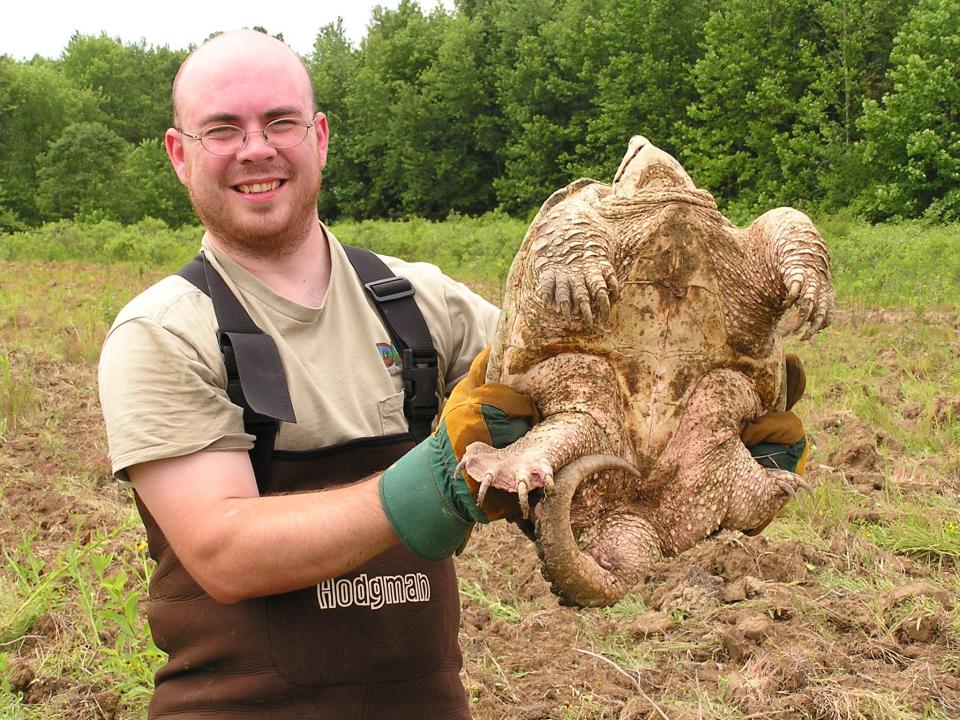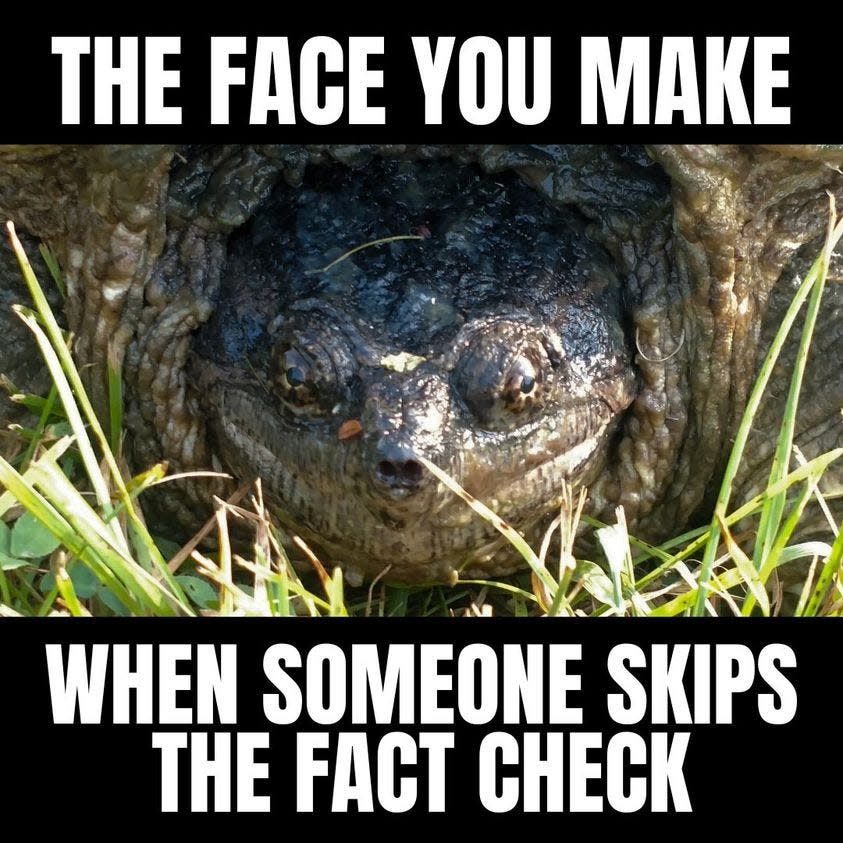No, there is no human-eating snapping turtle in Indiana.

Editor's note: The photo caption has been edited to correct the year it was taken and Walker's title.
Move over, one-eyed, one-horned, flying, purple people eater. There's a new long-named, possibly flesh-eating monster on the block.
As described in a viral Facebook post, forensic biologists with Purdue University have linked decapitated human remains at Lake Monroe to a reportedly deadly attack by a nine-foot, 300-year-old snapping turtle — the largest of such species ever recorded.
Lake Lemon's folklore based in truth: Where is Cemetery Island? A look at one of Monroe County's hidden histories
However, since that post initially went viral, spawning 14,000 shares and over 400 comments on Facebook, some key discrepancies have emerged.
There have not been any human remains recently found at Lake Monroe, as confirmed by the Monroe County Coroner's Office. There's also no record of the post's aforementioned forensic biologist, Dr. Eric Paddlejack, in Purdue University's directory. And there is certainly no nine-foot, 300-year-old snapping turtle swimming in Lake Monroe.
"It was way too sensational to be true," said Nate Engbrecht, a zoologist who studies reptiles and amphibians with the Indiana Department of Natural Resources.
It's a full-fledged internet hoax, which spread rapidly this week across social media platforms and generated hundreds of confused and suspicious comments.
Monroe County coroner, Indiana officials deny claims of man-eating turtle
The rumored discovery of a living turtle with Jurassic Park proportions seems to have originated from a Facebook post by Kevin Goodman, a private user based in this area.
Written in the format of a news article, Goodman described how a team of forensic scientists at Purdue University, led by Dr. Eric Paddlejack, "confirmed" the existence of the largest and oldest snapping turtle currently alive.
For Engbrecht, there were a couple of clues that immediately flagged this report as a fabricated tale.

"Right off the bat, the size was unreasonable for a native Indiana turtle,” Engbrecht said. "(Snapping turtles) are large turtles but certainly not nine feet.”
As Engbrecht notes, Lake Monroe is home to various turtle species — the spiny softshell turtle, which has a leathery shell as flat as a pancake; the red-eared slider turtle, which may be found in your home aquarium tank; and the musk turtle, which is about as big as a large avocado at Kroger.
In this region, a common snapping turtle's size ranges from 8 to 14 inches with a record length of approximately 19 inches — a far cry from 9 feet.
The estimated age was also a red flag.
While common snapping turtles typically have a lifespan of up to 40 years in the wild, there have been some cases of a few in captivity living just a bit longer than a century. Such is the case of Thunder, an alligator snapping turtle at the aquarium in Newport, Kentucky, who died in 2016 at the estimated age of 150 years old. There has been no snapping turtle ever recorded as old as 300 years.
As far as the man-killing claim goes, this also doesn't align with a snapping turtle's behavior. Despite the aggressive-sounding moniker, snapping turtles are often conflict-avoidant around humans. They only "snap" when they are provoked and feel they are in immediate danger.
"I mean, it’s important to know the difference between an animal being defensive and an animal being aggressive," Engbrecht said.
The turtles do not pose a deadly threat to humans, which makes the report of a decapitated body at the lake so jarring and eye-catching.
Beyond the sensational claims of age and size, there were some more subtle clues to the hoax. In Goodman's post, the main source is Dr. Paddlejack, a fictional person whose name derives from a kind of rubber fishing lure.
Shortly after the post went viral, a few local and state officials started shutting down the rumors.
One day after the initial claims began circulating, Monroe County Coroner Joani Stalcup took to her own Facebook page to denounce it as a "totally fabricated story." No human remains, nor evidence of a ginormous snapping turtle, have been recently found and recorded by Monroe County.
The Indiana Department of Natural Resources had a light-hearted response to the confusion and controversy.
"FYI: If you’re looking for turtles, we’ve got you covered. But if you’re looking for a nine-foot, 300-year-old snapping turtle, you might try your favorite comic book or horror film instead of Monroe Lake," DNR wrote via Facebook.
In another post from DNR's fish and wildlife division, state officials expanded on their response, emphasizing the importance of checking sources when reading something shocking or out of the ordinary.

"Luckily with these kinds of wildlife related stories, you can always directly ask us! Feel free to reach out about any tall tales you may hear regarding Indiana's fish and wildlife," DNR officials wrote.
While encouraging people to do independent research to prevent the spread of such extraordinary claims, Engbrecht also wanted to shed some light on the importance of conservation, especially given some turtle species being at risk of endangerment in Indiana.
“Even though snapping turtles are pretty common, (other turtles) face conservation challenges right now," Engbrecht said. "They could use some help and less fear (from people).”
Internet hoax was for 'proof of concept' screenplay pitch, creator says
On Tuesday, July 18, two days after the initial story was floated, Goodman posted again on Facebook, confirming the hoax and expanding on his intent behind it.
"For several years now, I have joked about writing a screenplay in the tradition of Lake Placid about a giant man-eating snapping turtle in Lake Monroe. I liked the idea because snapping turtles are large primitive scary-looking creatures, and yet, to the best of my knowledge, the idea of man-eating snapping turtles is novel," Goodman wrote. "But I felt it could be done with an air of plausibility."
It isn't that novel, in fact. There is a similar mythos in a different small Indiana town. In March of 1949, Churubusco, Indiana, made national headlines when there were alleged sightings of a monstrous turtle — 400 pounds of skin and shell, reportedly as big as a car — in the murky waters surrounding Fulk Lake. Divers began searching the lake for a chance at catching the Hoosier-equivalent of a Loch Ness monster, but no animal of such magnitude was ever confirmed.
Goodman decided to test the screenplay's viability and interest generation by writing a satire news story. With the idea of submitting it to the satirical media company the Onion, he posted it to his own social media account for a handful of close friends to read.
"Yes — I did want it to go viral, BUT I never imagined it would go viral from my personal Facebook page. I considered the article a draft, and I was looking for feedback and did not imagine it would escape my immediate circle of friends," Goodman wrote.
Goodman ended the post with a self-promotional spin: "At any rate, the 24 hours of turtle panic has proven my story concept has value. Movie rights are for sale!"
Reach Rachel Smith at rksmith@heraldt.com.
This article originally appeared on The Herald-Times: Internet hoax: human-eating snapping turtle in Indiana's Lake Monroe?

